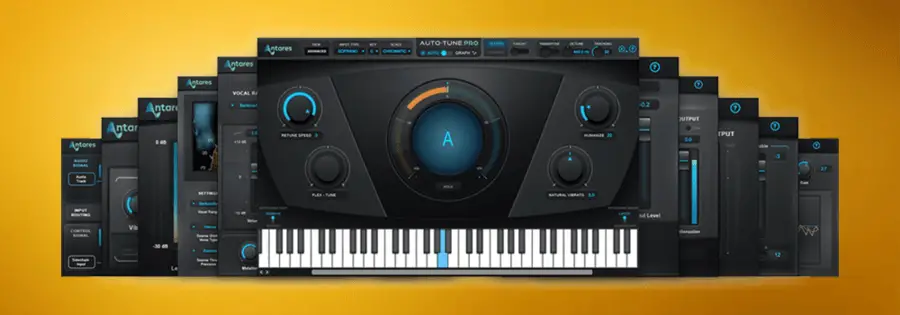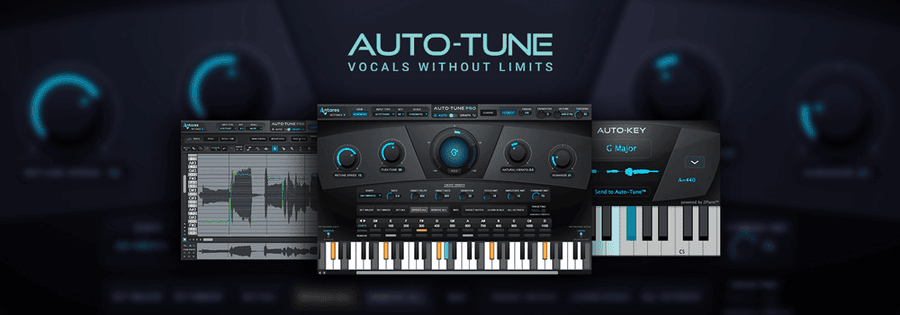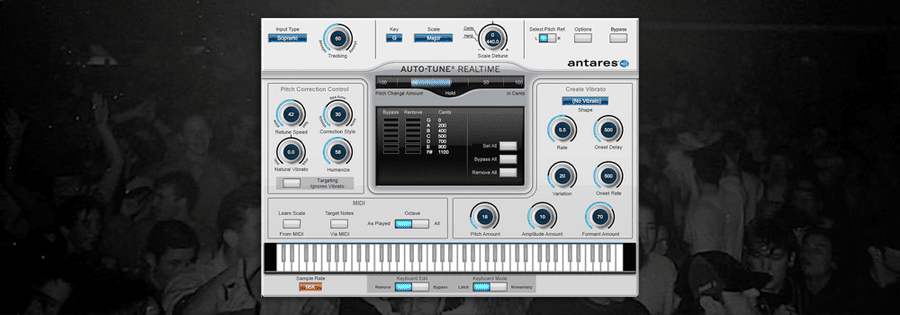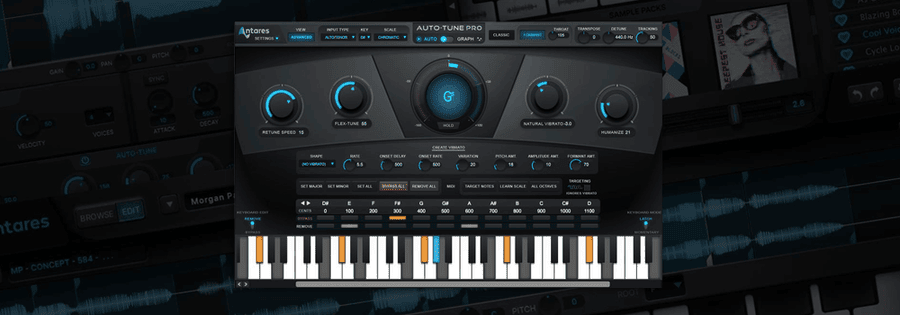Auto-Tune is a pitch correction tool that allows you to improve the intonation of your voice or other instruments. The software has made it possible for musicians to create professional-sounding vocal recordings without having to spend years learning how to sing like an expert. Whether you’re looking to smooth out your vocals or just want to add unique effects to your recordings, Auto-Tune allows you to perform at the highest level and create some exciting projects.
In this guide, we’ll unpack everything you need to know about Antares Auto-Tune, including a deep-dive into the software’s history, famous artists that use it and a discussion of its pros and cons.
- | What Is Auto-Tune & How Does It Work?
- | The History Of Auto-Tune & Its Use In Popular Music
- | The ‘T-Pain Effect’
- | How To Use Auto-Tune In Your Own Music
- | The Pros & Cons Of Auto-Tune
- | Famous Songs That Use Auto-Tune
- | Conclusion
Without further ado, let’s dive in!

| What Is Auto-Tune & How Does It Work?
Auto-Tune is one of the most commonly used digital audio processing tools in modern music production. It is a pitch correction software that is used to automatically correct pitch errors in recorded or live performances. Auto-Tune can be used to subtly improve the pitch of a recording, or it can be used to create dramatic, otherworldly effects. In recent years, Auto-Tune has become increasingly popular in rap, hip-hop and R&B music, where it is used to create a “robotic” or “detached” vocal sound. Whether you love it or hate it, there’s no denying that Auto-Tune has changed the sound of music.
Auto-Tune works by analyzing the pitch of each note in a recording and then correcting it to the nearest semitone, or half step. It uses a complex algorithm to analyze the waveform of a note and compare it to a database of known pitch values. If a note is off-key, Auto-Tune will automatically adjust it to the correct pitch. Auto-Tune is able to make the necessary adjustments to make you sound perfectly in tune.

| The History Of Auto-Tune & Its Use In Popular Music
Before Antares, another company called Eventide released a pitch correction device called the H910 Harmonizer. Released in the 1980’s, H910 was the first digital pitch correction device in the world and became very popular among musicians. However, H910 was very expensive and often unreliable. In 1997, a company called Antares released Auto-Tune which was a significantly more affordable and more advanced pitch correction tool.
Auto-Tune quickly became (and remains) the industry standard for pitch correction, and its distinctive “robotic” sound has become synonymous with modern music. The first major use of Auto-Tune was on Cher’s 1998 song “Believe.” The song was seen as groundbreaking at the time because no one had ever done anything like this before. After that, many artists began using Auto-Tune in their songs. The technology behind Believe has become increasingly popular in the music industry, to create unique create the vocal effects and to correct errors in pitch.
In popular music, Auto-Tune is often used to correct off-key singing and to enhance the pitch of vocal melodies. It can also be used to create unique vocal effects. When used sparingly, Auto-Tune can help to add depth and texture to a singer’s voice. When used excessively, however, it can give a singing voice an artificial and robotic quality. While some music purists decry the use of Auto-Tune, there’s no denying that it has become an essential tool for many top artists.

| The ‘T-Pain Effect’
The ‘T-Pain Effect’ refers to a particular way hip-hop artist T-Pain uses Auto-Tune on his vocals. The effect gives vocals blocky and robotic characteristics that cause vocals to sound far from natural sounding. T-Pain popularised this effect after incorporating it in many of his early singles like “I’m Sprung” and “Bartender.”
The effect can be achieved by setting the retune speed to 100%. Essentially, this means that there is no flexibility in the vocal tuning and ensures the vocals stay in the specified key 100% of the time. Since T-Pain’s 2005 debut album, Auto-Tune has helped to bring a multitude of new voices into the realm of hip-hop music. The ‘T-Pain Effect’ has inspired hip-hop artists like Travis Scott, Will.I.Am and Kanye West to use Auto-Tune in a very similar way.

| How To Use Auto-Tune Correctly
Auto-Tune is a powerful tool that can be used to produce amazing sounding recordings. However, if not used correctly, it can result in some not so pleasant sounding audio. Here are some tips on how to best use Auto-Tune in your own music productions:
1. Get Yourself A DAW – Using Auto-Tune with a DAW (Digital Audio Workstation) is the best way to use the software. Auto-Tune can be seamlessly integrated with popular DAWs like Ableton Live or Logic Pro which streamlines recording and editing using Auto-Tune.
2. Know The Key Your Working With – Knowing the key your recording is in is crucial as it determines which notes Auto-Tune will tune your recordings to.
3. Know When To Use It – It’s important to identify the contexts where using Auto-Tune is appropriate. Genres like classical music or screamo metal may not be the most fitting genres to use Auto-Tune. Auto-Tune is most commonly used in more modern popular genres like R&B, Rap, EDM etc.
4. Use It Sparingly – Using Auto-Tune sparingly on your vocals ensures that they still sound genuine and professional. The best way to do this is by controlling the level of pitch correction that occurs through each note.
5. Experiment – In addition to using Auto-Tune for pitch correction and vocal effects, you can try out the plugin on other instruments. Auto-Tune can be a great way to experiment with new sounds and ideas so don’t be afraid to play around with it and see what you can come up with.

| The Pros & Cons Of Auto-Tune
While Auto-Tune can be used to correct pitch problems and produce a polished sound, some purists argue that it ruins the natural flow of a performance and creates an artificial-sounding tone. Below are some of the pros and cons of using Auto-Tune in your own productions:
Pros:
-
- It can be used to fix mistakes in a vocal recording, making a song sound more polished overall.
- Auto-Tune can be used as an effect to create some original and unique sounds.
- Vibrato can be added to vocal performances using Auto-Tune.
- It can help musicians stay in tune with their instrument if they are having trouble doing so naturally.
Cons:
-
- It can take away from the natural flow of a song and make recordings sound robotic or fake.
- Priced at $399, Auto-Tune can be a costly tool for producers on a budget.
- It can take a lot of practice to get the most out of the software.

| Famous Songs That Use Auto-Tune
Up until a few decades ago, there was no way of adjusting the pitch of vocals in post-production. Since the software’s release in 1997, Auto-Tune has become one of the most used effects in pop music and has been used in countless songs. Here are some of the most famous songs that use Auto-Tune:
- T-Pain’s “Buy U A Drank”
- Kanye West’s “Love Lockdown”
- Daft Punk’s “One More Time”
- The Black Eyed Peas’s “Boom Boom Pow”
- Ke$ha’s “TiK ToK”
- Travis Scott’s “Goosebumps”
- Eiffel 65’s ‘I’m Blue”
- Cher’s “Believe”

| Conclusion
Auto-Tune is an extremely useful tool for both amateur and professional musicians alike. It’s a great way to fine tune your vocals and make sure that you’re hitting the right notes every time. With the right amount of practice, you can use Auto-Tune to make your vocals sound amazing. Whether you’re looking to experiment with Auto-Tune or just want to improve your singing skills naturally, there are plenty of resources out there to help you out. If you would like to learn more about Auto-Tune or buy it for yourself, click here.
Related Posts:
What Is Falsetto In Singing?
What Is The Forbidden Riff?
10 Tips For Producing Your First Hit Song
Want To Know More?
Here at Live Aspects, we have dozens of useful lessons and tutorials created to enhance your music production skills and help speed up the learning process. You can access our huge range of music theory lessons and production tips and tricks here.